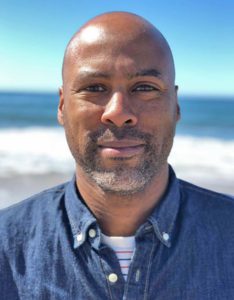 Michael Smith, AICP, is senior planner at the City of San Bruno Community Development Department. He volunteers as a member of his neighborhood design review board.
Michael Smith, AICP, is senior planner at the City of San Bruno Community Development Department. He volunteers as a member of his neighborhood design review board.
Tell us where you live, work, and attended school.
I live in San Francisco with my family and work for the City of San Bruno. I earned a master of city and regional planning at Cal Poly, San Luis Obispo, and a bachelor of arts in English from Chico State.
Your path to planning?
After college I started as a high school English teacher in East Oakland. It wasn’t a good fit for me, but the experience propelled my interest in planning. I was curious about the environment outside the school, wondering who and what was responsible for shaping the neighborhood. In pivotal conversations with my cousin, who was also considering a career in planning, we talked a lot about these issues. That’s when I decided to attend graduate school for planning. After grad school, I worked for the City and County of San Francisco for 15 years.
Tell us about differences between working in a large and small city.
San Francisco was a good training ground. I worked specifically in current planning. I went to San Bruno to get broader experience in a smaller city. As I had hoped, I definitely wear many different hats now. My work includes mentoring, supervising planners, and long range and current planning. The broader experience enriches my work.
How can planners gain skills as they work?
Skill and complexity don’t necessarily relate to the size of the project. It’s more in how many aspects of the project you touch. If you get exposed to what other departments care about, that’s where the richness comes in. As far as going to a big city? If you are new to planning or not sure which aspect interests you most, you may want to start in a smaller city — get to see the whole picture and decide what interests you before becoming a specialist. Depending upon your role, large cities often operate in silos, where departments are independent of each other. Your view of the possible specializations in planning is limited. If you’re not passionate about what you choose, you might burn out.
Whom do you really admire?
Ed Blakely, an urban planning professor I had at UC Berkeley. When I was working and living in Oakland, he was in the mayoral race. I thought it was interesting that a planner was running to be mayor. His campaign office was next door. It inspired me and I looked into what he championed. I found he was about planning justice.
[Ed. Note: Professor Blakely was Chair of the Department of City and Regional Planning at UC Berkeley from 1986 through 1994. From 2006 to 2009, he was Executive Director of Recovery Management for the City of New Orleans.]
Are you talking about environmental justice?
It’s more than that. It is about respect, representation, and inclusion for those who don’t have a voice in the community.
Tell us about a favorite project.
I worked on 1150 Ocean Avenue just west of CCSF. It was a really interesting mixed-use, mid-rise project. I liked it because it included multiple issues and gave me an opportunity to negotiate a development agreement for what we were trying to achieve on the site. Access concerns were complex and competed with other needs of the public streets. When you hear things in the conversation like “truncated yellow domes” (ADA ramp pads), you learn a lot about how to review a site design and the intersecting concerns of other disciplines such as long-range and transportation planning.
What good advice have you applied to get great results?
Planning is a noble profession but unfortunately it has become more associated with the enforcement of code. That’s something I heard in a session at the 2016 APA California Conference in Pasadena. It reminded me that, whatever I am trying to achieve in a project or plan, keep an eye on the bigger picture.
Your opinion: a great urban space in the Bay Area is ______.
Coit Tower or Belden Place (think Sam’s Grill off Bush Street): These are two very different places for two very different reasons. Coit Tower has magnificent views, and the structure serves no other purpose than as a landmark and symbol of beauty. Civic beautification projects are too few and far between. The tight confines of Belden Alley promote a very convivial atmosphere, which we need more in our society.
Planners are asked to both give advice to, and take direction from, leaders. How do you balance this role?
(Laughs). A planner must understand his/her role in the planning process. It’s more often an advisory role, making a recommendation to the decision makers who have to balance community interests that are at odds. I have witnessed planners undermine the department position because it was at odds with their planning worldview. Planners must either be OK with following direction that may conflict with their own planning values or be ready to move to a job where their vision and the organization’s are aligned. Planners are most useful in helping to define the issues and provide workable solutions for decision makers.
Interviewer Catarina Kidd, AICP, is Northern News’ associate editor. All interviews are edited.
